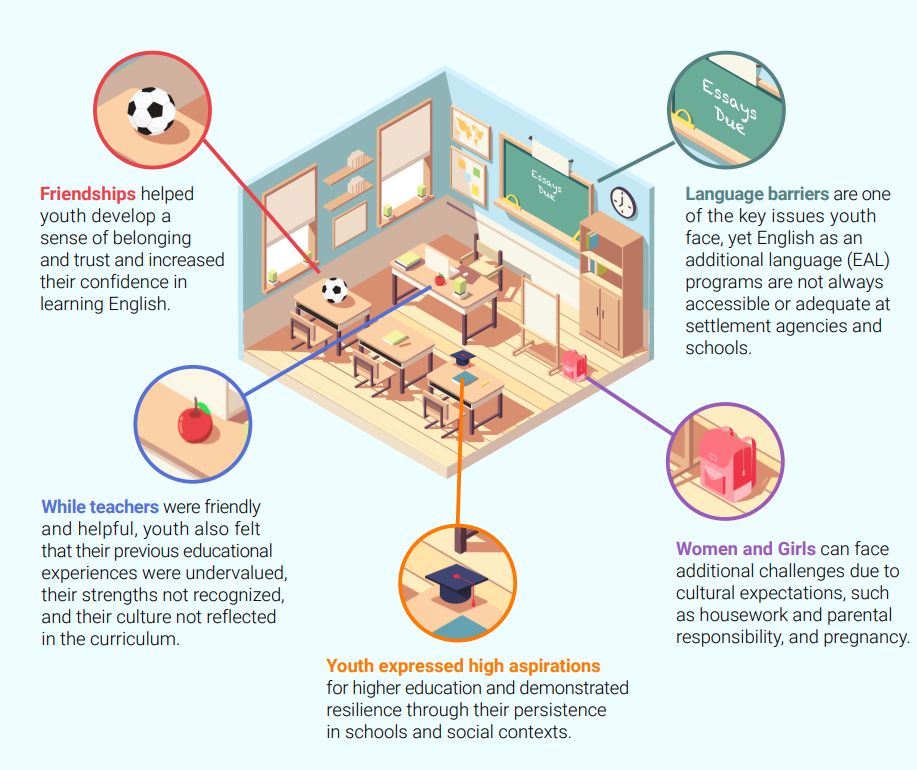Refugee Youth and Interrupted Schooling: Economic and Social Implications
Research Team: Susan M Brigham1, Howard Ramos2, Nabiha Atallah3, Olga Lyobenko3, Sylvia Calatayud1,3, Claire Brierley1
Affiliations: Mount Saint Vincent University (MSVU)1, Western University2, and Immigrant Services Association of Nova Scotia (ISANS)3
Research Partner: Immigrant Services Association of Nova Scotia (ISANS)
Keywords: Refugee youth, interrupted schooling, language skills, educational attainment, English as an additional language (EAL), Nova Scotia, qualitative research
Jump to: Full Infographic, Methodology, Findings
Summary
Overview: This study looked at the schooling experiences of 25 refugee youth living in Halifax, Nova Scotia, aged 16 to 26 years old, who have experienced interrupted schooling.
Objective: To highlight the complex challenges faced by refugee youth who have experienced
interrupted schooling and understand the cultural and linguistic resources and agency youth use to navigate, interact, and occupy cultural and educational spaces.
Research Justification: Refugees are increasingly settling in mid-sized cities, such as Halifax. Refugee
youth are at a high risk of experiencing interrupted schooling, defined as not being able to attend school
for a period that can vary from a few months to years due to war, civil unrest, migration, or financial
pressures. Interrupted schooling is a significant challenge for refugee youth’s integration and academic
success.
Infographic Excerpt

Methodology
The research team conducted one-on-one interviews with 25 refugee youth (22 female and 3 male) who migrated to Canada as government-assisted refugees (GARs) and currently reside in Halifax, Nova Scotia. Youth were 16 to 26 years old and came from Latin America, the Caribbean, and Africa. Experiences of interrupted schooling ranged from two months to never having the opportunity to attend school. Participants had been in Canada from 15 days to 10 years.
A theoretical framework of transnationalism and transnational identities was applied to participants’ narratives. A transnational perspective acknowledges the processes migrants engage in to create social fields linking their countries of origin and their countries of settlement and how these fields structure everyday practices.
Findings
- Language
- Language barriers prevented youth from being able to access school, post-secondary education, work, and social spaces.
- English as an additional language (EAL) programs are not always accessible or adequate at settlement agencies and schools.
- Friendships
- Friendships helped youth develop a sense of belonging and trust and create a community where they could get support.
- Peers helped youth increase their confidence in learning English.
- Gender
- Women and girls may face additional challenges due to cultural expectations, such as housework and parental responsibility, and pregnancy.
- Aspirations & Resilience
- Participants expressed high aspirations for higher education and careers, such as becoming doctors, nurses, and engineers.
- Youth demonstrated resilience through their persistence in schools and social contexts.
- School Experiences
- Some participants felt that their previous educational experiences were ignored or undervalued meaning that they were not sufficiently challenged or able to advance in certain subjects, such as math.
- Youth felt they were not reflected in the school curriculum, which was overly focused on European history and culture.
- Teachers were described as friendly, helpful and patient, yet they sometimes failed to consider the resilience and strength of refugee youth.
- Refugee youth who have experienced trauma require acknowledgement and support from teachers and experts.
Explore more projects


